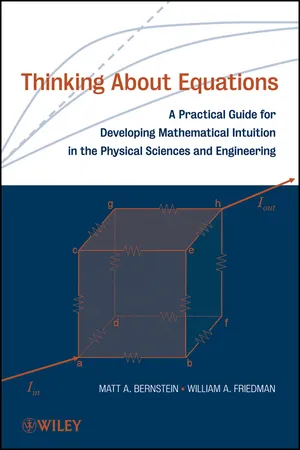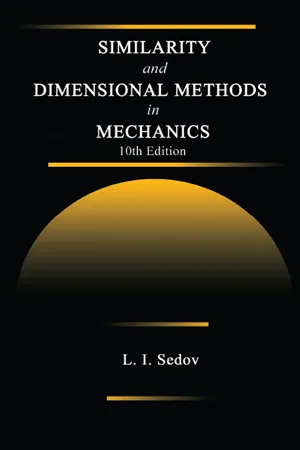Technology & Engineering
Dimensional Equation
A dimensional equation is an equation that expresses the relationship between physical quantities in terms of their dimensions. It helps in understanding the fundamental properties and behavior of the quantities involved. By analyzing the dimensions of different physical quantities, dimensional equations can be used to derive new equations and verify the consistency of mathematical expressions in engineering and technology.
Written by Perlego with AI-assistance
Related key terms
9 Key excerpts on "Dimensional Equation"
- eBook - ePub
The Reform of the International System of Units (SI)
Philosophical, Historical and Sociological Issues
- Nadine de Courtenay, Olivier Darrigol, Oliver Schlaudt(Authors)
- 2019(Publication Date)
- Routledge(Publisher)
concept of quantity is important because of the role that quantities have in the quantity equations expressing the fundamental laws of science.4.2 Quantity equations and Dimensional Equations
On Lodge’s approach (as with the approach I took in Sterrett (2009)), quantity equations express the fundamental laws of physics as relations between quantities. Quantity equations must be dimensionally homogeneous, but the constraint of dimensional homogeneity on an equation is like a grammatical constraint on a statement; just as there is much more to a statement than its grammatical structure, so there is much more to an equation of physics than homogeneity of dimensions. Another way to put this is to point out that the Dimensional Equation one would write to show that the quantity equation is dimensionally homogenous is not necessarily as informative as the quantity equation itself is. For example, consider the equation s = a t 2 , where s is a distance, a is an acceleration and t is a time, considered as a quantity equation. The Dimensional Equation is [L] = [L] [T]− 2 [T]2 or [L] = [L].Where do Dimensional Equations fit in the logical scheme of developing a system of units? They are not the beginning point, for Dimensional Equations are relative to the quantity equations expressing the fundamental laws of the science one is concerned with. (We saw that, even in Fourier’s presentation of how to determine the exponents of dimensions of the units for various quantities, a necessary prior step was identifying the three quantities with respect to which the exponents of dimension were to be determined.) Dimensional Equations are also relative to the selection of which of the quantities in those quantity equations is designated for use as a base dimension - Bruce C. Gates, Robert L. Powell(Authors)
- 2023(Publication Date)
- CRC Press(Publisher)
4 Units, Dimensions, and Dimensional AnalysisDOI: 10.1201/9781003429944-4Roadmap
The dimensions that are characteristic of all physical quantities provide insight into physical processes. We review the basic ideas of dimensions and units, showing the usefulness of the fact that each term in an equation must have the same dimensions. The essential point of this chapter is that, solely through analysis of the dimensions, it is possible to predict the forms of equations representing physical phenomena; the process is called dimensional analysis. Terms that are combined to form dimensionless groups appear frequently in the analysis of physical phenomena and sometimes provide simple criteria for such phenomena, illustrated by laminar and turbulent flow predicted by the dimensionless group called the Reynolds number. Dimensional analysis is illustrated for the draining of water from a tank through an orifice in its base, confirming the results developed in Chapter 2 .Dimensions
We associate the word “dimensions” with figures and objects; examples of dimensions are lengths, depths, and radii. In geometry, two points are separated by a distance—the length of the straight line connecting them—this is a dimension. Dimensions have units; we commonly measure lengths in meters (m) or feet (ft). Periods of time have dimensions that we usually express in the units of seconds (s), minutes (min), or hours (h). Fundamental physical quantities such as the velocity of light and the velocity of sound in air have dimensions measured in units such as meters per second (m×s−1 [m s−1 ]). All physical properties of gases, liquids, and solids, such as density, thermal conductivity, and viscosity, have dimensions. Density is often measured in units of kg m−3 .Fundamental dimensions include length (L), time (T), mass (M), and force (F). Other fundamental dimensions, such as those encountered in electricity and magnetism, are left out of our discussion because we do not consider such phenomena in this book.- eBook - ePub
- Ron Darby, Raj P. Chhabra(Authors)
- 2016(Publication Date)
- CRC Press(Publisher)
2 Dimensional Analysis and Scale-Up“Today’s scientists have substituted mathematics for experiments, and they wander off through equation after equation, and eventually build a structure which has no relation to reality.”—Nikola Tesla, 1856–1943, InventorI. INTRODUCTIONIn this chapter, we consider various aspects of dimensions and units and the different systems in use for describing these quantities. In particular, the distinction between scientific and engineering systems of dimensions is explained, and the various metric and English* units used in each system are discussed. It is important that the engineer be familiar with both English and metric systems, as they are all in common use in various fields of engineering and will continue to be for the indefinite future. It is common to encounter a variety of units in different systems during the analysis of a given problem, and the engineer must be adept at dealing with all of them.The concept of conservation of dimensions will be applied to the dimensional analysis and scale-up of engineering systems. It will be shown how these principles may be used in the design and interpretation of laboratory experiments on “model” or “prototype” systems to predict the behavior of large-scale (“field” or “real”) systems (this process is also known as similitude). These concepts are presented early on, because we shall make frequent use of them in describing the results of both theoretical and experimental analyses of engineering systems in a form that is the most concise, general, and useful. These methods can also provide guidance in choosing the best approach to follow in the solution of many complex problems.II. UNITS AND DIMENSIONSA. DIMENSIONSThe dimensions of a quantity identify the physical character of that quantity, for example, force (F), mass (M), length (L), time (t), temperature (T), electric charge (e), etc. On the other hand, units identify the reference scale by which the magnitude of the respective physical quantity is measured. Many different reference scales (units) can be defined for a given dimension; for example, the dimension of length can be measured in units of miles, centimeters, inches, meters, yards, angstroms, furlongs, light years, kilometers, etc. Dimensions can be classified as either fundamental or derived. Fundamental dimensions are those that cannot be expressed in terms of any other dimensions and include length (L), time (t), temperature (T), mass (M), and/or force (F) (depending upon the system of dimensions used). Derived dimensions can be expressed in terms of fundamental dimensions. Using the notation that “[x] = the dimensions of x,” we see, for example, that area ([A] = L2 ), volume ([V] = L3 ), energy ([E] = FL = ML2 /t2 ), power ([HP] = FL/t = ML2 /t3 ), viscosity([μ] = Ft/L2 = M/Lt), thermal conductivity ([k] = ML/t3 - eBook - ePub
Thinking About Equations
A Practical Guide for Developing Mathematical Intuition in the Physical Sciences and Engineering
- Matt A. Bernstein, William A. Friedman(Authors)
- 2011(Publication Date)
- Wiley(Publisher)
6 INTRODUCTION TO DIMENSIONAL ANALYSIS AND SCALINGIn Chapter 1, we discussed the dimensions of variables and constants that represent physical quantities, and we also discussed several systems of units that are in common use. Methods for performing dimensional checks were presented, and we discussed how those methods can be used to generalize equations and simplify algebraic calculations. In this chapter, we continue that discussion by describing some of the basic aspects of dimensional analysis and scaling.6.1 DIMENSIONAL ANALYSIS: AN INTRODUCTIONAs described in Chapter 1, equations that accurately depict or model the physical world must be dimensionally consistent. This means that all of the terms (i.e., quantities added or subtracted together) in a valid equation must have the same dimensions. Dimensional analysis exploits the same principle: it uses the dimensions of physical quantities to assist in the construction of equations.Dimensional analysis is based on the concept that the underlying mathematical description of any physical process must be independent of the specific choice of measurement units. Therefore, it should be possible to describe that process in terms of dimensionless quantities. For example, the motion of a mass on a spring is the same regardless of whether we choose to measure it in units of meters or inches. True, the numerical values of the constants appearing in the equations of motion will differ, but the description of the physical process must be independent of our choice of units.Through the use of dimensional analysis, it is often possible to develop equations that solve problems that otherwise might be very difficult to attack. The examples presented in this chapter illustrate how dimensional analysis can provide such equations or symbolic expressions up to an unspecified function, or in some cases up to an unspecified constant. - eBook - ePub
- J. David Logan(Author)
- 2013(Publication Date)
- Wiley(Publisher)
scaling. The former permits us to understand the dimensional (meaning length, time, mass, etc.) relationships of the quantities in the equations and the resulting implications of dimensional homogeneity. Scaling is a technique that helps us understand the magnitude of the terms that appear in the model equations by comparing the quantities to intrinsic reference quantities that appear naturally in the physical situation. A side benefit in scaling differential equations, for example, is in the great economy it affords; more often than not, the number of independent parameters can be significantly reduced.1.1.2 Dimensional Methods
One of the basic techniques that is useful in the initial, modeling stage of a problem is the analysis of the relevant quantities and how they must relate to each other in a dimensional way. Simply put, apples cannot equal oranges plus bananas; equations must have a consistency to them that precludes every possible relationship among the variables. Stated differently, equations must be dimensionally homogeneous. These simple observations form the basis of the subject known as dimensional analysis. The methods of dimensional analysis have led to important results in determining the nature of physical phenomena, even when the governing equations were not known. This has been especially true in continuum mechanics, out of which the general methods of dimensional analysis evolved.The cornerstone result in dimensional analysis is known as the Pi theorem. The Pi theorem states that if there is a physical law that gives a relation among a certain number of dimensioned physical quantities, then there is an equivalent law that can be expressed as a relation among certain dimensionless quantities (often noted by π1 , π2 ,…, and hence the name). In the early 1900s, E. Buckingham formalized the original method used by Lord Rayleigh and gave a proof of the Pi theorem for special cases; now the theorem often carries his name. Birkhoff (1950) can be consulted for a bibliography and history.Example 1.1
(Atomic explosion) To communicate the flavor and power of this classic result, we consider a calculation made by the British applied mathematician G. I. Taylor in the late 1940s to compute the yield of the first atomic explosion after viewing photographs of the spread of the fireball. In such an explosion a large amount of energy E is released in a short time (essentially instantaneously) in a region small enough to be considered a point. From the center of the explosion a strong shock wave spreads outward; the pressure behind it is on the order of hundreds of thousands of atmospheres, far greater than the ambient air pressure whose magnitude can be accordingly neglected in the early stages of the explosion. It is plausible that there is a relation between the radius of the blast wave front r, time t, the initial air density ρ, and the energy released E. Hence, we assume - eBook - ePub
- L. I. Sedov(Author)
- 2018(Publication Date)
- CRC Press(Publisher)
T (in the engineering system of units, the unit symbol of force will be denoted by the letter S). The dimension of units can be mentioned only in application to a definite system of units of measurement. For example, L2 will be the area dimension and L/T the velocity dimension; in the physical system of units, the force dimension will be ML/T2 , and in the engineering system it will be S.Hereafter, for denoting the dimension of a certain quantity a, we shall use the symbol [a], which was introduced by Maxwell. For example, for the dimension of force F in the physical system we shall write.or[ F ]=M LT 2= SM LT 2Dimensional formulas are convenient for converting the value of a dimensional quantity from one system of units to another. For example, measuring acceleration due to gravity in centimeters and seconds, we get g = 981 cm/s2 . If it is required to transform from these units of measurement to kilometers and hours, then to convert the identified value of the acceleration due to gravity, the following relation should be used:therefore;1 cm =1km,10 51 s =1 3600hg = 981cm= 981s 2= 98.1 ×1 /10 5km(21 / 3600)h 236 2km.h 2On the whole, if in the new system of units the unit of length is smaller by a factor of α, the unit of mass by a factor of β, and the unit of time by a factor of γ in comparison with the previous units, then the value of the physical quantity a, which has the dimension [a] = Ll Mm Tn , in the new system is increased by a factor of αl βm γn.The number of basic units of measurement should not necessarily be equal to three. It is possible to take more than three basic units. Thus, for example, units of measurement for four quantities—length, time, mass, and force—can be independently established by experiment. In that case, Newton’s equation will take the form - eBook - ePub
Quantitative Ecology
Measurement, Models and Scaling
- David C. Schneider(Author)
- 2009(Publication Date)
- Academic Press(Publisher)
If we are simply using the equation as a recipe for calculating one number from other numbers, without using units or dimensions, then we easily miss something important, which is the space and time scale at which the equation applies. If we treat the equation as expressing an idea about measurable quantities with a particular scope (range relative to resolution), we are aware of the limits of the equation. It is a curious fact that ecology throughout most of the 20 th century paid no attention to time and space scales (Figure 2.3). The tradition has been to apply equations as though they had neither units nor dimensions (Table 1.2). The tradition was to treat equations as though they had no scale, even though measured quantities clearly do have a scale set by the measurement protocol that determines their scope (range/resolution). This tradition will eventually disappear. Its demise can be hastened by adopting the convention that all quantities in a concept expressed as an equation must have a stated resolution and range, with clear statement of spatial and temporal attributes. Another Look at Section 13.4 Try putting Equation 13.2 into your own words. Then try Equation 13.1. 13.5. Dimensional Homogeneity The principle of dimensional homogeneity, introduced in Chapter 6, is an important tool in working with equations. The principle is used to check the validity of an equation, work out units and dimensions of unknown quantities, and gain a better understanding of the idea expressed by an equation. The principle of dimensional homogeneity of an equation states that an equation about measured quantities must be dimensionally homogeneous. Terms that are added (or subtracted) must have the same units and dimensions (Rule 6, Table 6.7), an extension of the apple/orange principle from Chapter 4 - eBook - ePub
- William S. Janna(Author)
- 2020(Publication Date)
- CRC Press(Publisher)
Measurements on the model can then be scaled up to predict performance of the prototype even though the prototype has not been built. Clearly, the cost is considerably less. Modeling wind flow past a building, for example, is an economical way of finding the effect of a hurricane on the structure. Thus, modeling problems have many useful applications. In this chapter, we will see how dimensionless ratios are used in modeling problems. 4.1 DIMENSIONAL HOMOGENEITY AND ANALYSIS An equation must be dimensionally homogeneous. That is, all terms in the equation must have the same dimensions or units. To compare dimensions of various terms within an equation, it is convenient to first convert the dimensions into fundamental units. Suppose we are working within the British gravitational system, in which force (F), length (L), and time (T) are considered fundamental. Mass (M) is a derived unit defined as M = F · T 2 / L. Consider, for example, the Bernoulli equation, derived in Chapter 3 : p ρ + V 2 2 + g z = a constant If we use the generalized notation, the dimensions of each term become p ρ = F L 2 L 3 M = F L 2 L 3 L F ⋅ T 2 = L 2 T 2 V 2 2 = L 2 T 2 g z = L T 2 L = L 2 T 2 Thus, each term has dimensions of L 2 / T 2 in a system in which F, L, and T dimensions are considered fundamental (British gravitational system). On the other hand we could reformulate the dimensions of the Bernoulli equation in the system in which only mass (M), length (L), and time (T) are fundamental (SI system). Force is a derived unit defined as F = M · L / T 2. Evaluating the Bernoulli equation in this system, we get p ρ = M ⋅ L T 2 1 L 2 L 3 M = L 2 T 2 V 2 2 = L 2 T 2 g z = L T 2 L = L 2 T 2 In Chapter 1, we discussed the English engineering system, in which force, mass, length, and time are considered fundamental. In this system, equations are often written with a conversion factor because mass and force are both considered fundamental - eBook - ePub
- Guillaume Delaplace, Karine Loubière, Fabrice Ducept, Romain Jeantet(Authors)
- 2015(Publication Date)
- ISTE Press - Elsevier(Publisher)
2.1.1 Physical quantities and measures. Dimensions and unit systems
2.1.1.1 Physical quantities and dimensions
Science uses physical quantities (or entities)1 which need to be measured or calculated in order to establish predictive mathematical relationships linking the causes of a studied phenomenon to its effects. Such quantities may be a force, a moment, a mass and a velocity of bodies (solid, liquid or gas), energy or time, etc.Each quantity has a number of independent properties: it’s scalar or vector nature, its intensity, sign and dimension.For instance, if the quantity is a velocity, it has a vector nature and its dimension is a length per unit time. However, if the quantity being studied is a distance, it has a scalar nature and its dimension is a length.Therefore, it will be noted that physical quantities which describe a phenomenon have several properties and that one of them is their dimension , which specifies the physical nature of the quantity.2.1.1.2 Measure of physical quantity
Several possibilities are available to the user for expressing the external or internal measure of a physical quantity.2.1.1.2.1 External measure
In order to obtain the external measure of a physical quantity, its dimension is referenced in terms of a standard outside the system. This is why the numerical value of a physical quantity is expressed in the form of a number (measure ) and a unit (external standard ):numerical value of a physical quantity = measure × unitTherefore, the measure of a physical quantity cannot be unique and depends on the reference unit (the standard).[2.1]Example 2.1 External measure (I)When the dimension is a length, the meter can be used as a standard. 0.2 is, therefore, the measure of the physical quantity which corresponds with a double decimeter. This physical quantity has length as its dimension is expressed in meters (unit).
Index pages curate the most relevant extracts from our library of academic textbooks. They’ve been created using an in-house natural language model (NLM), each adding context and meaning to key research topics.








